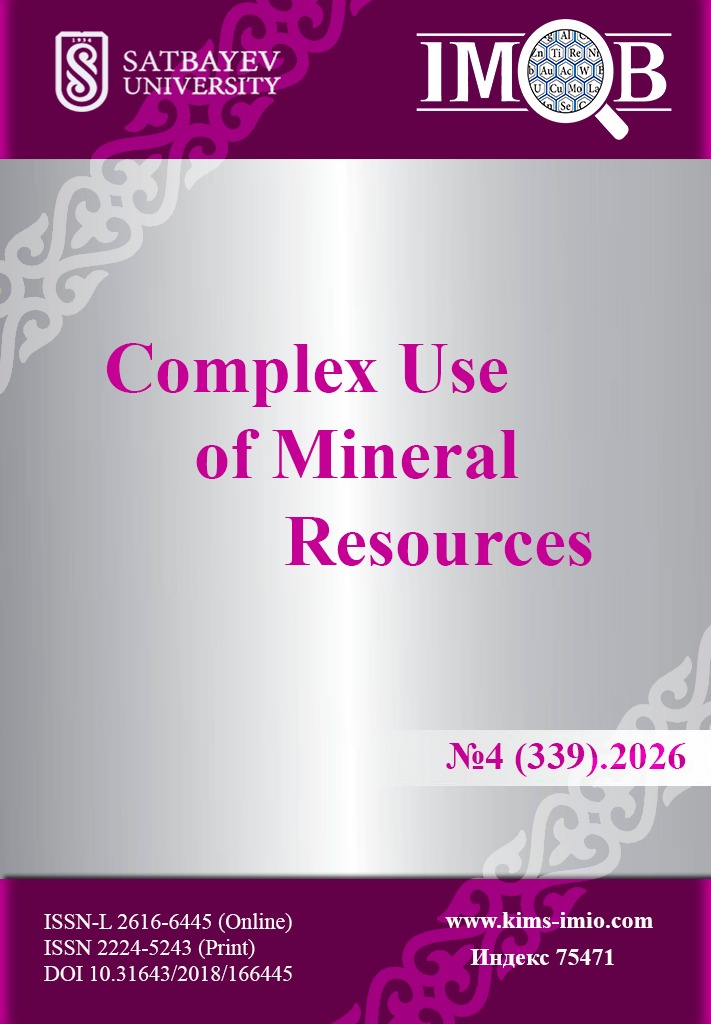Use of fly ash and ground tuff as pozzolanic additives in lightweight structural
DOI:
https://doi.org/10.31643/2026/6445.39Keywords:
fly ash, pozzolanic effect, tuff, binder, lightweight structural concrete.Abstract
This paper investigates the effect of partial replacement of cement with fly ash and ground volcanic tuff on the physical and mechanical properties of concrete. The main focus is on the changes in average density and compressive strength at different contents of replacement materials (from 10% to 35%). The investigated concrete composition (27PPPF) without admixtures has an average density of 1925.5 kg/m³ and compressive strength of 40.1 MPa. The results show that when fly ash is added, the concrete strength first increases, reaching a maximum value of 41.6 MPa at 10% cement replacement and then decreases to 29.1 MPa at 35% replacement. A similar trend is observed when tuff is introduced, but the peak strength (40.7 MPa) is also reached at 10% replacement, after which the strength gradually decreases to 27.9 MPa at 35%. The average density of the specimens changes insignificantly, being in the range of 1910.4-1928.5 kg/m³, which indicates that the dense structure of the concrete is maintained. Thus, the optimum content of fly ash and tuff in the concrete composition is 10-15%, as these values provide the best mechanical characteristics. Higher dosages of substitutes result in lower strength due to thinning of cement stone and lack of binding properties. This study confirms the possibility of using fly ash and volcanic tuff as effective pozzolanic additives to improve the environmental friendliness and sustainability of concrete.
Downloads
References
Khoshroo M, Shirzadi Javid AA, Shalchiyan M, et al. Evaluation of Mechanical and Durability Properties of Concrete Containing Natural Chekneh Pozzolan and Wood Chips. Iran J Sci Technol Trans Civ Eng. 2020; 44:1159-1170. https://doi.org/10.1007/s40996-019-00305-8
Htwe KS, Mon YPP. Effect of Natural Pozzolan on Carbonation and Chloride Penetration in Sustainable Concrete. Int J Adv Sci Eng Inf Technol. 2018; 8(4):1049-1054. https://ijaseit.insightsociety.org/index.php/ijaseit/article/view/4340
Annune JE, Yohanna A, Oguche CA, Wali CB. Experimental Research on Natural Pozzolan as Cement Replacement. ABUAD Int J Nat Appl Sci. 2023; 3(1):28–33. https://journals.abuad.edu.ng/index.php/aijnas/article/view/140
Oviedo I, Pradena M, Link Ó, Balbo JT. Using Natural Pozzolans to Partially Replace Cement in Pervious Concretes: A Sustainable Alternative? Sustainability. 2022; 14(21):14122. https://doi.org/10.3390/su142114122
Abutaqa A, Mohsen MO, Aburumman MO, et al. Eco-Sustainable Cement: Natural Volcanic Tuffs’ Impact on Concrete Strength and Durability. Buildings. 2024; 14(9):2902. https://doi.org/10.3390/buildings14092902
Golewski GL. The Role of Pozzolanic Activity of Siliceous Fly Ash in the Formation of the Structure of Sustainable Cementitious Composites. Sustain. Chem. 2022; 3(4):520-534. https://doi.org/10.3390/suschem3040032
Musungu Khaoya L, Abuodha S, Mwero JN. Effects of Volcanic Tuff Use on the Rheological and Mechanical Properties of Self-Compacting Concrete. DJES. 2024; 17(3):78–97.
Hardjito D. The Use of Fly Ash to Reduce the Environmental Impact of Concrete. EnCon2007. Kuching, Malaysia. 2007.
Onyelowe KC, Kontoni D-PN, Ebid AM, et al. Multi-Objective Optimization of Sustainable Concrete Containing Fly Ash Based on Environmental and Mechanical Considerations. Buildings. 2022; 12(7):948. https://doi.org/10.3390/buildings12070948
GOST 31108-2020. Cements. Technical Specifications.
Moawad MS, Younis S, Ragab AER. Assessment of the Optimal Level of Basalt Pozzolana Blended Cement Replacement Against Concrete Performance. J Eng Appl Sci. 2021; 68:42. https://doi.org/10.1186/s44147-021-00046-4
GOST 30744-2001. Cements. Testing Methods Using Polyfractional Sand.
ASTM C1723-10(2015), Standard Guide for Examination of Hardened Concrete Using Scanning Electron Microscopy.
Cobîrzan N, Thalmaier G, Balog A-A, Constantinescu H, Ceclan A, Nasui M. Volcanic Tuff as Secondary Raw Material in the Production of Clay Bricks. Materials 2021; 14(22):6872. https://doi.org/10.3390/ma14226872
Zhuginissov M, Kuldeyev Y, Nurlybayev R, et al. Lightweight Structural Thermal Insulation Concrete Using TPP Ash. Kompleksnoe Ispolzovanie Mineralnogo Syra = Complex Use of Mineral Resources. 2024; 336(1):74–85. https://doi.org/10.31643/2026/6445.07
GOST 310.2-76 Cements. Methods for Determining Fineness of Grinding.
Isaenko AV, Aleksandrova TI. Vliyanie tonkosti pomola negashenoy izvesti na filtratsionnye svoystva shlako-izvestkovykh avtoklavnykh materialov [Influence of the Fineness of Quicklime Grinding on the Filtration Properties of Slag-Lime Autoclaved Materials]. Vestnik Severo-Vostochnogo federalnogo universiteta im. M. K. Ammosova = Bulletin of the North-Eastern Federal University Named After M.K. Ammosov. 2011; 8(2):67–69. (in Russ.). https://cyberleninka.ru/journal/n/vestnik-severo-vostochnogo-federalnogo-universiteta-im-m-k-ammosova?i=1144573
Rashchupkina MA. Vliyanie dispersnosti zoly gidroudaleniya Ekibastuzskikh ugley i dobavki zhidkogo stekla na svoystva melkozernistogo betona [Influence of the Dispersity of Hydraulically Removed Ash from Ekibastuz Coals and the Addition of Liquid Glass on the Properties of Fine-Grained Concrete] (PhD dissertation). Novosibirsk, 2009. VAK RF Specialty 05.23.05. (in Russ.). https://tekhnosfera.com/vliyanie-dispersnosti-zoly-gidroudaleniya-ekibastuzskih-ugley-i-dobavki-zhidkogo-stekla-na-svoystva-melkozernistogo-beton?utm
Kozhikov SN, Dzhusupova MA. Razrabotka sostavov kompozitsionnykh vyazhushchikh veshchestv i izdeliy na ego osnove s ispolzovaniem zoly Ekibastuzskoy TEC [Development of Composite Binders and Products Based on Them Using Ekibastuz TPP Ash.]. Mekhanika i tekhnologii = Mechanics and Technologies. Scientific Journal. 2024; 3(85):240-246. (in Russ.). https://doi.org/10.55956/GJDU7225
Izotov VS, Mukhametrakhimov RH. Vliyanie tonkosti pomola kvartsevogo peska na fiziko-tekhnicheskie svoystva avtoklavirovannykh fibrotsementnykh plit [Influence of Quartz Sand Grinding Fineness on the Physico-Technical Properties of Autoclaved Fiber Cement Boards]. Stroitel'nye materialy, oborudovanie, tekhnologii XXI veka. Krovel'nye i izolyatsionnye materialy = Construction Materials, Equipment, Technologies of the XXI Century. 2013; (10):22–23. (in Russ.). https://rucont.ru/efd/425508?utm
Nath P, Sarker P. Effect of Fly Ash on the Durability Properties of High Strength Concrete. Procedia Engineering. 2011; 14:1149-1156. https://doi.org/10.1016/j.proeng.2011.07.144
Safonov VD, Petrova SP. Analiticheskiy obzor primeneniya zoly TEC v proizvodstve betona [Analytical review of the application of thermal power plant ash in concrete production]. Molodoy uchyonyy = Young scientist. 2020, 13(303):25-28. (in Russ.). https://moluch.ru/archive/303/68468/?utm
Sokolov AA. Vliyanie puccolanovuh dobavok na beton [Influence of Pozzolanic Additives on Concrete]. Jcement.ru. (in Russ.). https://jcement.ru/magazine/vypusk-1-391/vliyanie-puttssolanovykh-dobavok-v-betonakh-na-reaktsiyu-shchelochi-s-kremnezemom-pri-postuplenii-shch/?utm
Ivanov AN, Petrov IM. Issledovanie vliyaniya zolnyh ostatkov pererabotki tverdyh bytovyh othodov na svoistva cementa I betonov na ego osnove [Study of the Influence of Ash Residues from Municipal Waste Processing on the Properties of Concrete]. Cyberleninka.ru. (in Russ.). https://cyberleninka.ru/article/n/issledovanie-vliyaniya-zolnyh-ostatkov-pererabotki-tverdyh-bytovyh-othodov-na-svoystva-tsementa-i-betonov-na-ego-osnove?utm
Downloads
Published
How to Cite
Issue
Section
License
Copyright (c) 2025 M.T. Zhuginissov, E.I. Kuldeyev, R.E. Nurlybayev, Y.Y. Khamza, Y.S. Orynbekov, A.А. Iskakov

This work is licensed under a Creative Commons Attribution 4.0 International License.


























